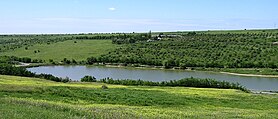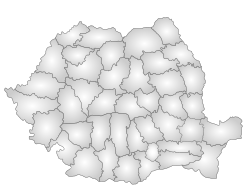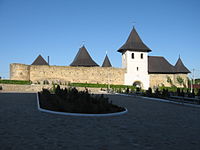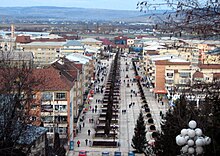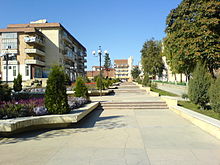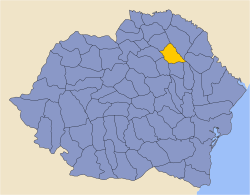
Neamț County is a county (județ) of Romania, in the historic region of Moldavia, with the county seat at Piatra Neamț. The county takes its name from the Neamț River.
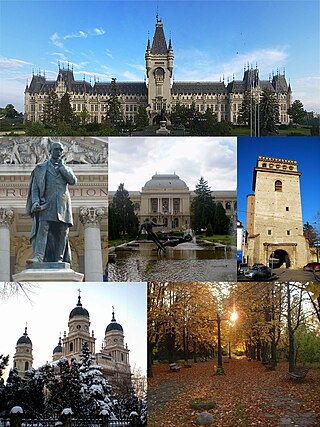
Iași, also referred to mostly historically as Jassy, is the third largest city in Romania and the seat of Iași County. Located in the historical region of Moldavia, it has traditionally been one of the leading centres of Romanian social, cultural, academic and artistic life. The city was the capital of the Principality of Moldavia from 1564 to 1859, then of the United Principalities from 1859 to 1862, and the capital of Romania from 1916 to 1918.

Botoșani County is a county (județ) of Romania, in Western Moldavia, with the county seat at Botoșani.

Dolj County is a county (județ) of Romania on the border with Bulgaria, in Oltenia, with the capital city at Craiova.

Vaslui County is a county (județ) of Romania, in the historical region Western Moldavia, with the seat at Vaslui.

Mureș County is a county (județ) of Romania, in the historical region of Transylvania, with the administrative centre in Târgu Mureș. The county was established in 1968, after the administrative reorganization that re-introduced the historical județ (county) system, still used today. This reform eliminated the previous Mureș-Magyar Autonomous Region, which had been created in 1952 within the People's Republic of Romania. Mureș County has a vibrant multicultural fabric that includes Hungarian-speaking Székelys and Transylvanian Saxons, with a rich heritage of fortified churches and towns.

Bacău County is a county (județ) of Romania, in Western Moldavia, with its capital city at Bacău. It has one commune, Ghimeș-Făget, in Transylvania.

Hârlău is a town in Iași County, Western Moldavia, Romania. It was one of the princely court cities of Moldavia, in the 15th century. One village, Pârcovaci, is administered by the town.

Cucuteni is a commune in Iași County, Western Moldavia, Romania, with a population of 1,446 as of 2002. The commune is composed of four villages: Băiceni, Bărbătești, Cucuteni, and Săcărești.

Cotnari is a village and the center of the eponymous commune in Iași County, Romania, in the historical region of Western Moldavia. It is located north-west of Iași and south of Hârlău, in a major wine-producing region of Romania, and is famous for the wine variety known as Grasă de Cotnari. Cârjoaia, the forest of Dumbrava Roșie, and other sites in Cotnari are regional tourist spots.

Belcești is a commune in Iași County, Western Moldavia, Romania. One of the county's largest communes, with a population of 10,231 as of 2021, it is composed of six villages: Belcești, Liteni, Munteni, Satu Nou, Tansa, and Ulmi.
The Bahlueț is a right tributary of the river Bahlui in Romania. It discharges into the Bahlui in Podu Iloaiei. Its length is 41 km (25 mi) and its basin size is 551 km2 (213 sq mi).

Podu Iloaiei is a town in Iași County, Western Moldavia, Romania. It has 8,992 inhabitants as of 2021, and was declared a town in 2005. Four villages are administered by the town: Budăi, Cosițeni, Holm, and Scobâlțeni.

The A8 motorway, also known as The Union Motorway or the East-West Motorway is a planned motorway in Romania, that will cross the Eastern Carpathians to connect the historical regions of Moldavia and Transylvania. It will directly link the cities of Iași and Târgu Mureș. The A8 motorway route is an integral part of the Trans-European Transport (TEN-T) Core Network.

The First Battle of Târgu Frumos was fought during World War II between Axis powers commanded by Otto Wöhler and Soviet forces led by Ivan Konev. Historian David Glantz has described it as part of a failed Soviet invasion of Romania, while Russian and German sources have described it as part of the Târgu Frumos Operation.

The first Jassy–Kishinev offensive, named after the two major cities in the area, Jassy and Kishinev, was a series of military engagements between 8 April and 6 June 1944 by the Soviet Union and Axis powers. Richard C. Hall also refers to a first Jassy–Kishinev operation which began on 5 April, without providing an exact date for its end. According to Glantz, the purported offensive was a coordinated invasion of Romania conducted by Red Army's 2nd and 3rd Ukrainian Fronts, in accordance with Joseph Stalin's strategy of projecting Soviet military power and political influence into the Balkans. However, according to the German Military History Research Office, a threatened Soviet offensive in northern Moldavia "failed to materialize" in the first part of April, and the military engagements during the rest of the month were used by the Axis forces to straighten the frontline; furthermore, on 6 May, the main command of the Soviet military (Stavka) issued orders to take no further offensive actions in this sector of the front.
This article discusses the administrative divisions of the Kingdom of Romania between 1941 and 1944. As a result of the Soviet occupation of Bessarabia and Northern Bukovina, Second Vienna Award and the Treaty of Craiova, territories that had previously been part of Romania were lost to the Soviet Union, Hungary and Bulgaria respectively. By September 1940 the administrative system set up in 1938 based on 'ținuturi' (regions) was disbanded and the former counties (județe) were reintroduced.

Baia County is one of the historic counties of Moldavia, Romania. The county seat was Fălticeni.

Tecuci County was a county in the Kingdom of Romania, in the historical region Moldavia. The county seat was Tecuci.




